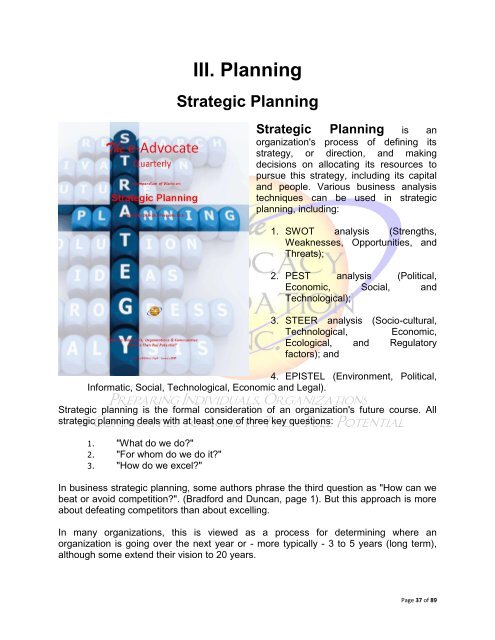The Nonprofit Incubator
The Nonprofit Incubator
The Nonprofit Incubator
Create successful ePaper yourself
Turn your PDF publications into a flip-book with our unique Google optimized e-Paper software.
III. Planning<br />
Strategic Planning<br />
Strategic Planning is an<br />
organization's process of defining its<br />
strategy, or direction, and making<br />
decisions on allocating its resources to<br />
pursue this strategy, including its capital<br />
and people. Various business analysis<br />
techniques can be used in strategic<br />
planning, including:<br />
1. SWOT analysis (Strengths,<br />
Weaknesses, Opportunities, and<br />
Threats);<br />
2. PEST analysis (Political,<br />
Economic, Social, and<br />
Technological);<br />
3. STEER analysis (Socio-cultural,<br />
Technological, Economic,<br />
Ecological, and Regulatory<br />
factors); and<br />
4. EPISTEL (Environment, Political,<br />
Informatic, Social, Technological, Economic and Legal).<br />
Strategic planning is the formal consideration of an organization's future course. All<br />
strategic planning deals with at least one of three key questions:<br />
1. "What do we do?"<br />
2. "For whom do we do it?"<br />
3. "How do we excel?"<br />
In business strategic planning, some authors phrase the third question as "How can we<br />
beat or avoid competition?". (Bradford and Duncan, page 1). But this approach is more<br />
about defeating competitors than about excelling.<br />
In many organizations, this is viewed as a process for determining where an<br />
organization is going over the next year or - more typically - 3 to 5 years (long term),<br />
although some extend their vision to 20 years.<br />
Page 37 of 89

















